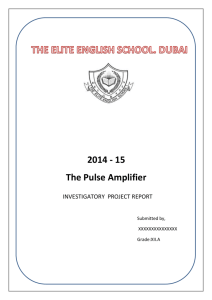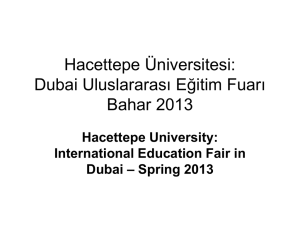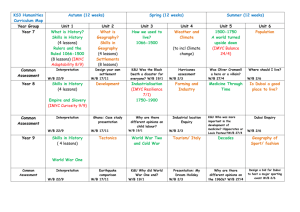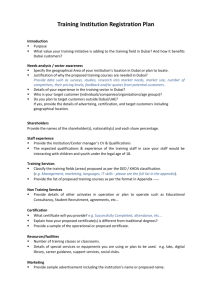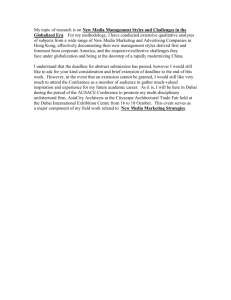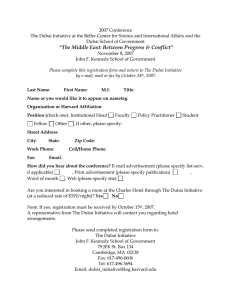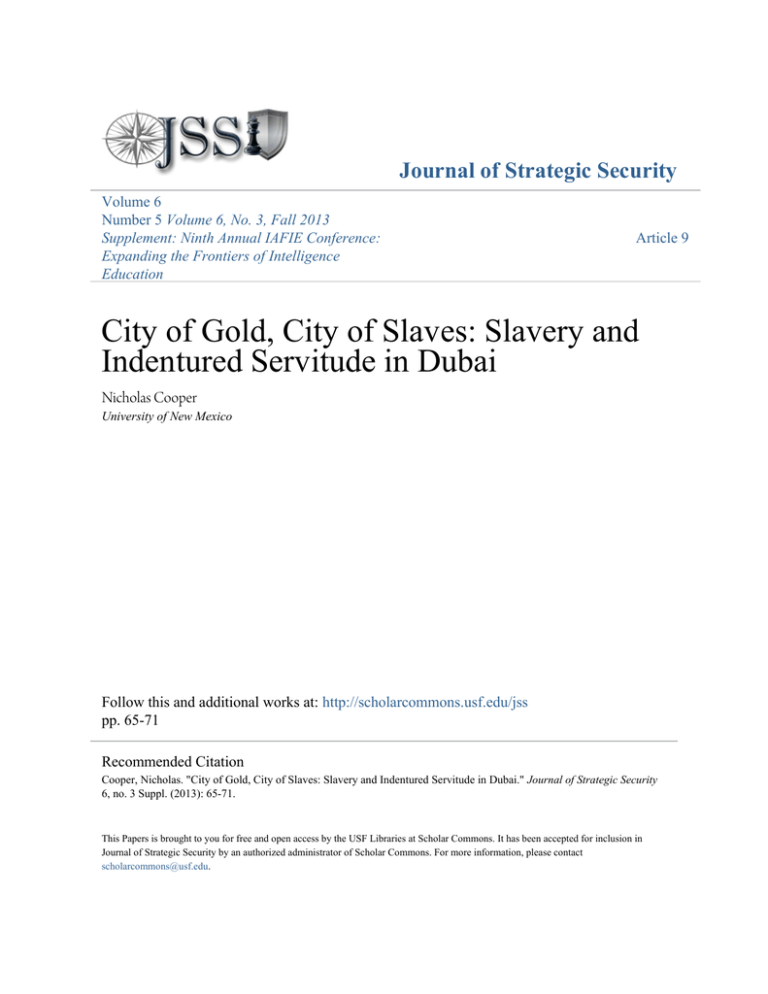
Journal of Strategic Security
Volume 6
Number 5 Volume 6, No. 3, Fall 2013
Supplement: Ninth Annual IAFIE Conference:
Expanding the Frontiers of Intelligence
Education
Article 9
City of Gold, City of Slaves: Slavery and
Indentured Servitude in Dubai
Nicholas Cooper
University of New Mexico
Follow this and additional works at: http://scholarcommons.usf.edu/jss
pp. 65-71
Recommended Citation
Cooper, Nicholas. "City of Gold, City of Slaves: Slavery and Indentured Servitude in Dubai." Journal of Strategic Security
6, no. 3 Suppl. (2013): 65-71.
This Papers is brought to you for free and open access by the USF Libraries at Scholar Commons. It has been accepted for inclusion in
Journal of Strategic Security by an authorized administrator of Scholar Commons. For more information, please contact
scholarcommons@usf.edu.
Cooper: City of Gold, City of Slaves
City of Gold, City of Slaves: Slavery and Indentured Servitude in
Dubai
Nicholas Cooper
Findings and Recommendations
In the past two decades, the city of Dubai has experienced exponential growth, made possible by
vigorous foreign investment and its robust tourism industry. However, beneath the glossy visage
of the city lies a foundation of pervasive human rights violations; primarily slavery. Slavery
presents itself primarily in the construction industry, enabled by the exploitation of immigrant
construction workers. Additionally, many of the wealthy elite manipulate immigration processes
in order to keep immigrant women as their personal domestic servants, subjecting them to a life
of indentured servitude and slavery. The sex trade is also prevalent in Dubai, as many women are
trafficked from all over the world to the city to serve as prostitutes for businessmen clientele.
Additionally, many women arrive willingly, signing contracts to become domestic workers or
work in Dubai businesses, only to have employers confiscate their passports and force them to
work as prostitutes. This is partially enabled by the abuse of the United Arab Emirate’s residence
visa system.
The forms of slavery detailed here are enabled not only by international criminal organizations
and corrupt businesses, but by the corruption and/or ineffectual malaise of the local and state
governments in the region, as well as foreign embassies. Widespread reforms should be instated
to help those in slavery get out and to punish those responsible.
Possible reforms would include increased enforcement of human trafficking offenses,
prosecution of traffickers and recruitment agents, institution of clearer formal procedures for law
enforcement and Ministry of Labor officials to identify victims of trafficking, providing
protection to victims of abuse, ensuring that trafficking victims are not punished for unlawful
acts committed as a direct result of being trafficked, and the institution of education initiatives
about human trafficking and forced labor. Additionally, a large part of responsibility would have
to be taken by investors and companies in Dubai, ensuring that their business practices are lawful
and not exploitative. It would be the responsibility of the United Arab Emirates government and
local administration to implement these reforms, but other states and international investors
would also have to pressure administration and Dubai businesses in order for any of these
reforms to be created.
History of Dubai
In the mid-18th century, Dubai was founded as a small village. The city had relative wealth due
to its pearl industry, and it soon began to accumulate population from Persia, the Indian
subcontinent, and other Arab countries. The city was under British rule until the last vestiges of
British colonialism in the area were withdrawn in 1971. Shortly thereafter, oil was discovered,
and the previously nomadic sheikhs in control of the Dubai now had enormous fortunes. The city
only had a small amount of oil resources compared to other cities in the area, and as a result its
ruler Sheikh Maktoum decide to use the money to attract tourism and financial services from
around the world. Over the next few decades millions came, attracted to the lack of taxes, and
65
Produced by The Berkeley Electronic Press, 2013
Journal of Strategic Security, Vol. 6 No. 5
overcame the local population; today only 5% of Dubai’s population is comprised of locals.1
Over the past two decades Dubai has grown astonishingly fast, with credit, cheap labor and taxfree incentives promoting foreign investment and immigration.
Between 2000 and 2005 the GDP had a growth rate of 13% per year, and the GNP reached 37
billion US dollars; in five years achieving more than their projections for growth over a ten year
period.2 Dubai’s growth has been slowed, however, by vast debt; especially since the world
financial crisis. The Abu Dhabi government and the UAE central bank gave $20 billion in loans
to Dubai in late 2009 in a multi-billion-dollar debt restructuring effort, and although Dubai is on
track repaying it, the city is still billions of dollars in debt.3
While slowed by the global economic recession, Dubai has continued to grow with solid
investment in foreign trade with some of the world's fastest growing economies such as China,
India and other emerging economies, though faced with declining trade and investment
opportunities linked to Europe. The growth driven by trade, tourism and hospitality sectors is
described as sustainable for the Dubai economy by the Dubai Department of Economic
Development, and the organization forecast GDP growth of 4.1 per cent in 2012 based on these
industries; slower than that of the early 2000s but still substantial.4
To illustrate the massive economic and physical growth of the city, the photos below show a
comparison of the Shiekh Zayed Road between 1990 and 2012.
1990
2012
As can be seen, Dubai has grown exponentially over the past twenty years, with hundreds of new
skyscrapers built. Today Dubai is a newborn metropolis only a few decades from the sparseness
of a small desert city.
1
Johann Hari, “The dark side of Dubai,” The Independent (UK) April 7, 2009, available at:
http://www.independent.co.uk/voices/commentators/johann-hari/the-dark-side-of-dubai-1664368.html .
2
Lara Lynn Golden, “H.H. Sheikh Mohammad unveils highlights of Dubai Strategic Plan (2015) - Dubai...Where
the Future Begins,” AME Info (UAE) February 3, 2007, available at: http://www.ameinfo.com/109572.html.
3
Zawya Dow Jones, “Dubai on track to repay a $10b loan,” Gulf News (UAE) October 21, 2012, available at:
http://gulfnews.com/business/economy/dubai-on-track-to-repay-a-10b-loan-1.1092236.
4
Babu Das Augustine, “Trade will drive emirate's economy this year,” Gulf News (UAE) February 16, 2012,
available at: http://gulfnews.com/business/economy/trade-will-drive-emirate-s-economy-this-year-1.981551.
66
http://scholarcommons.usf.edu/jss/vol6/iss5/9
DOI: http://dx.doi.org/10.5038/1944-0472.6.3S.7
Cooper: City of Gold, City of Slaves
Indentured Labor
To understand the massive growth in Dubai, the construction and labor industries must be taken
into account. Dubai’s enormous skyscrapers and human-engineered islands are built by the
efforts of hundreds of thousands of foreign laborers, and it is only through this influx that the
city’s expansion is possible. According to the Government of Dubai Statistics Center, a
staggering 96% of its employed population is made up of immigrant workers; Dubai is
unquestionably dependent on this population.5
Migrant workers are recruited from India, Pakistan, Bangladesh, Nepal, Sri Lanka, Indonesia,
Ethiopia, Eritrea, China, Thailand, Korea, Afghanistan, Iran, and the Philippines. In the UAE,
migrant workers that are employed in the private sector are sponsored by UAE citizens under
employment contracts for one to three years. These contracts are subject to renewal. If not
renewed, once a migrant worker’s work permit expires that worker (and their family) must leave
the country.6 However, for many migrant workers the situation is not this simple.
Workers are hired from local recruitment agencies in their home countries working on behalf of
UAE based businesses. Generally, workers are charged a fee by their prospective employer
(normally over $1000 U.S.) to procure their visa and plane ticket to the UAE.7 The money often
has to be borrowed or family land sold under the impression that within 18 months the debt can
be repaid.8 Even though this is a customary practice among agencies, these kinds of recruitment
charges are expressly forbidden under UAE law.9
When workers arrive in Dubai, they are systematically subjected to exploitation by their
employers. Upon arrival passports are confiscated in an attempt to prevent employees from
leaving. 10 The workers cannot leave the country without a passport, and thus are barred from
returning home. This is illegal but is still a widespread practice among companies in the city.
Additionally, migrant workers are denied their wages for at least the first few months, in an
attempt by the employer to prevent their employees from leaving. Large amounts of employers
do not pay their workers on a regular basis, creating a huge backlog of debt for the migrant
workers. Additionally, in many cases workers are also abandoned by their employers. Some
employers hold back paying wages to their workers for many months and then flee the country,
leaving employees with virtually no options to survive or leave their situation.11 When wages are
5
Government of Dubai. Bulletin of Labour Force Survey Results (2011), available at:
http://www.dsc.gov.ae/Publication/%D9%86%D8%B4%D8%B1%D8%A9%20%D9%85%D8%B3%D8%AD%20%
D8%A7%D9%84%D9%82%D9%88%D9%89%20%D8%A7%D9%84%D8%B9%D8%A7%D9%85%D9%84%D8
%A9%202011.pdf.
6
Human Rights Watch. Building Towers, Cheating Workers (2006), available at:
http://www.hrw.org/reports/2006/uae1106/uae1106web.pdf.
7
Ibid.
8
Lila Allen, “Dark side of the Dubai dream,” BBC (UK) April 6, 2009, available at:
http://news.bbc.co.uk/2/hi/uk_news/magazine/7985361.stm.
9
Federal Law No. 8 For 1980, On Regulation of Labor Relations, art. 18, available at:
http://www.deg.gov.ae/sitecollectionimages/content/pubdocs/uae_labour_law_eng.pdf.
10
Johann Hari, “The dark side of Dubai,” 2009.
11
Human Rights Watch. Building Towers, Cheating Workers, 2006.
67
Produced by The Berkeley Electronic Press, 2013
Journal of Strategic Security, Vol. 6 No. 5
paid, they are generally much less than those promised originally, which creates even more
problems between workers and collection agencies in their home countries.12
Laborers are forced to work long hours in the dangerous desert heat on construction projects, and
are not given sufficient breaks as required by law. Health and safety violations are rampant on
construction projects, and the government does not enforce these regulations thoroughly. 13
Workers describe the large number of deaths from heat exhaustion, overwork and suicide, but
government records do not reflect this. Human Rights Watch described a “cover-up” of the true
numbers of injuries and fatalities of migrant workers in Dubai; out of nearly six thousand
construction companies in Dubai, only six reported any kind of injuries to the Ministry of Labor.
In 2005, the government of Dubai reported only 39 deaths by workers by all nationalities in the
entire country. The Indian consulate alone recorded 971 death cases in 2005, of which 61 were
registered accidents. 14 These numbers indicate discrepancies in the health and safety reports of
the workers, and at the very least gross oversight by the Dubai authorities.
After long days of hard labor working in life-threatening heat, migrants are exploited even
further. Workers live in company-run shanty towns and face a life of squalor. The largest is a
town called Sonapur, with a population of over 300,000 foreign workers. “Sonapur,” ironically,
means “City of Gold” in Hindi.15
In Sonapur and camps like it, conditions are appalling. Sewage systems are broken and
deplorable, basic utilities are inadequate and the heat is unbearable for many. Water provided is
not desalinated properly, and laborers describe sickness caused from drinking it. Workers also
face dehydration and heatstroke, among other ailments. Camps are extremely overcrowded; one
article details a camp of 7,500 laborers sharing 1,248 rooms with poor ventilation, with sewage
leaking all over the worker’s quarters.16 For the vast majority of migrants these slums are their
only option for housing, and neither the 14-hour workdays nor the miserable quarters they return
to offer any reprieve.17
Workers have very few options to leave these situations. Unionizing is forbidden, and most
workers have no recourse other than the Labor Ministry. 18 Workers have gone on several strikes,
but horrible conditions still persist. As a result, a mentality of desperation and hopelessness
arises in many workers, and this translates into suicides for a substantial number for a large
number of migrant workers.
Being that the Indian consulate in Dubai is one of the only relatively reliable sources of
information about migrant deaths, most figures of suicides come from that embassy. In 2005
12
Ghaith Abdul-Ahad, “We need slaves to build monuments,” The Guardian (UK) October 7, 2008, available at:
http://www.guardian.co.uk/world/2008/oct/08/middleeast.construction.
13
Human Rights Watch. Building Towers, Cheating Workers, 2006.
14
Ibid.
15
Johann Hari, “The dark side of Dubai,” 2009.
16
Lila Allen, “Dark side of the Dubai dream,” 2009.
17
Johann Hari, “The dark side of Dubai,” 2009.
18
Hassam . Fattah, “In Dubai, an Outcry From Asians for Workplace Rights,” The New York Times (USA) March
26, 2006, available at:
http://www.nytimes.com/2006/03/26/international/middleeast/26dubai.html?pagewanted=all&_r=0.
68
http://scholarcommons.usf.edu/jss/vol6/iss5/9
DOI: http://dx.doi.org/10.5038/1944-0472.6.3S.7
Cooper: City of Gold, City of Slaves
alone 84 Indian nationals committed suicide in Dubai, and this is not even taking into account
any of the other nationalities that work in Dubai.19 Even in the past few years Dubai has not been
able to eliminate these suicides; for example, in 2011 a worker jumped to his death off of the
tallest building in the world, Burj Khalifa, after his employer denied granting him leave to go
home.20 As we have seen with deaths in construction sites, companies and the government do not
report accurate numbers on worker deaths and exact numbers and suicide are imprecise. Records
provided by the government on worker deaths are suspiciously incomplete and do not match up
with estimates provided by state embassies. Discrepancies exist between the tally taken by
embassies and the numbers officially reported by the government.21
Domestic Slavery
In Dubai slavery does not stop at construction labor exploitation. Another bastion of human
rights violations in the city is the servitude and abuse of thousands of migrant domestic worker
women.
Similarly to construction laborers, domestic workers are hired by recruitment agencies in their
home countries, primarily from Sri Lanka, Indonesia and the Philippines. Many women
volunteer for domestic work as nannies or maids for the Emirati elite, looking for work and
opportunity working in a foreign country. They too incur debts paying the recruitment agencies
excessive fees to finance their visas and travel fees.22 Domestic workers are recruited through a
legal sponsorship that links the employment and the residency of a domestic worker to a specific
employer, similar to that of a migrant laborer. This sponsorship requires all unskilled laborers to
have an in-country sponsor, usually their employer, who is responsible for their visa and legal
status. Domestic workers enter these bonding contracts with employers they have not yet
interacted with, leaving them in a position vulnerable to abuse and exploitation. 23
When they arrive in Dubai, the worker’s passports are confiscated, and from then on their
employers have extensive control over them.24 Domestic workers are usually hired to work in
their master’s house doing housework, and often live in their home as well. As such, these
women face a unique problem; their employers have control over them every waking hour of the
day. Domestic workers are often denied freedom of movement, and are either locked inside or
forbidden to leave the home without permission. They are forced to work excessive hours with
little or no pay, and have no way to escape. 25 Once in control of a situation like this, their
19
Human Rights Watch. Building Towers, Cheating Workers. 2006.
Human Rights Watch. World Report 2012: United Arab Emirates
http://www.hrw.org/sites/default/files/related_material/uae_2012.pdf
21
Human Rights Watch. Building Towers, Cheating Workers, 2006.
22
Romina Halabi, “Contract Enslavement of Female Migrant Domestic Workers in Saudi Arabia and the United
Arab Emirates,” Human Rights and Social Welfare, University of Denver. (2008), available at:
http://www.du.edu/korbel/hrhw/researchdigest/slavery/fmd.pdf.
23 Cecily Hilleary, “Modern Slaves: Domestic Migrant Workers in Kuwait, UAE, Saudi Arabia,” Middle
East Voices (USA) May 15, 2012, available at:
http://middleeastvoices.voanews.com/2012/05/modern-slaves-domestic-migrant-workers-in-kuwaituae-saudi-arabia-23585/.
24
Johann Hari, “The dark side of Dubai,” 2009.
25
Romina Halabi, “Contract Enslavement of Female Migrant Domestic Workers in Saudi Arabia and the United
Arab Emirates,” 2008.
20
69
Produced by The Berkeley Electronic Press, 2013
Journal of Strategic Security, Vol. 6 No. 5
employers can potentially force them to do work day or night with threats; ranging from physical
violence to starvation to withheld pay.
Domestic workers are routinely abused by their employers. From beatings to rape, women face
violence in conditions in which they are prisoners twenty four hours a day, seven days a week.
Grisly stories include a woman who was viciously stabbed and disfigured by her employer and a
maid whose employer beat her head against the wall and battered her with broomsticks after
starving her for years.26 27
Most of the time domestic workers have no way out of their situation. Even if a maid or nanny
manages to escape from their employer’s home, most have no knowledge of Arabic and cannot
function in society. Since the employers hold the migrant’s passport, changing jobs is a nearly
impossible task, and they cannot leave the country without it. Some seek help in their home
country’s embassy, but most are apathetic and cannot do much without the worker’s passport,
which is still in the hands of their employer. If a maid reports her abuse to the police or
government after running away, she is charged with the crime of running away from her
employer and breaching contract.28 When an Ethiopian maid attempted suicide in the street to
escape her hopeless situation, she was found by the police and arrested for attempted suicide;
illegal in Dubai.29 Systematically, when women act in response to their abuse they are charged
by the government with crimes themselves; effectively women in Dubai face an environment in
which they are punished for speaking out in abusive situations.
Sexual Slavery
Domestic spheres are not the only places where migrant women are exploited and abused. Dubai
is one of the biggest tourist destinations on Earth, and as such many arrive for on vacation and in
search of pleasure. Human trafficking organizations make that pleasure accessible to thousands
through the vast prostitution network in the city.
Sex slavery presents itself through two main venues; the complex sex trafficking system which
brings women from many parts of the world to work as sex slaves in Dubai, and the exploitation
of young women out of work in the city by pimps. There are over 30,000 foreign prostitutes in
the city, and a large number of these women are trafficked slaves or exploited servants.30 Many
26
Awad Mustafa, “Man stabbed maid several times and left her disfigured, court hears,” The National (UAE)
February 13, 2012, available at:
http://www.thenational.ae/news/uae-news/courts/man-stabbed-maid-several-times-and-left-her-disfigured-courthears.
27
“Modern-Day Slavery in the UAE: Unpaid Filipino Maid Beaten and Starved for Years,” Migrant Rights
(Bahrain) March 2, 2010, available at:
http://www.migrant-rights.org/2010/03/02/modern-day-slavery-in-the-uae-unpaid-filipino-maid-beaten-andstarved-for-years/.
28
Johann Hari, “The dark side of Dubai,” 2009.
29 Erik Orkitz, “Maid attempts suicide in Dubai and is FINED after she’s rescued,” New York Daily News
(US) October 1, 2012, available at:
http://www.nydailynews.com/news/world/maid-fined-suicide-rescue-article1.1171872#commentpostform.
30
William Butler, “Why Dubai's Islamic austerity is a sham – sex is for sale in every bar,” The Guardian (UK) May
15, 2010, available at:
70
http://scholarcommons.usf.edu/jss/vol6/iss5/9
DOI: http://dx.doi.org/10.5038/1944-0472.6.3S.7
Cooper: City of Gold, City of Slaves
women are trafficked to Dubai and forced to work against their will. Females are trafficked from
Eastern Europe, Central Asia, Southeast Asia, the Far East, East Africa, Iraq, Iran, and Morocco
and subjected to forced prostitution, and UAE does not fully comply with the minimum
standards for the elimination of trafficking, according to United States State Department.31 Many
women sign contracts to become domestic workers or work in Dubai businesses, only to have
employers confiscate their passports and force them to work as prostitutes.32 These women, like
hundreds of thousands all around the world, are trafficked into a life of sexual slavery.
Stringent laws exist against any kind of public sexual behavior in Dubai, and tourists are
imprisoned from acts as small as kissing in a restaurant or sending lewd text messages.33
Prostitution is strictly illegal under United Arab Emirates' and Islamic law, but is widely
accepted within the city. Implementation of anti-trafficking or anti-prostitution regulations is
severely lacking, and authorities rarely enforce these laws. As a result, huge numbers of foreign
men procure illegal sex services every day.34
Part of what allows prostitution to flourish in Dubai is its residence visa system. Every Emirati
citizen is entitled to a certain number of residence visas with which to hire foreign workers. Most
Emiratis don’t use all of their available visas, and sell the extras to middlemen who trade them
on to women who want to work in the city. Thousands of women even sign up willingly as
prostitutes to escape destitution in their home countries. However, many of these women are then
exploited and forced to work as sexual slaves.35 Conditions for rape, physical abuse and financial
exploitation are also very prevalent in these women’s situations.
As is the case with domestic servants, women in abusive situations rarely find help from their
home embassies. The local government and police are ineffectual, and Dubai remains a
dangerous place to even report rape. After reporting rape, some women have been arrested for
“illegal sex acts,” and women who have been sexually assaulted face the possibility of being
punished themselves.36 In particular, sexual slaves have the fewest options of escaping their
situation.
http://www.guardian.co.uk/world/2010/may/16/dubai-sex-tourism-prostitution; Glen Carey, “Dubai's Promised
Land of Luxury Lures Women Into Sexual Slavery,” Bloomberg (US) November 5, 2007, available at:
http://www.bloomberg.com/apps/news?pid=newsarchive&sid=amKSCFA_Fm3s.
31
United States State Department. Trafficking in Persons Report 2012, available at:
http://www.state.gov/documents/organization/192598.pdf.
32
Glen Carey, “Dubai's Promised Land of Luxury Lures Women Into Sexual Slavery”
33
Barbara Surk, “Dubai Kissing Couple: Jail Sentence Upheld For U.K. Couple Arrested For Kissing,” The
Huffington Post (US) April 4, 2010, available at:
http://www.huffingtonpost.com/2010/04/04/dubai-kissing-couple-jail_n_524736.html.
34
William Butler, “Why Dubai's Islamic austerity is a sham – sex is for sale in every bar,” 2010.
35
Ibid.
36
Nadya Khalife, “Dubai’s shameful record on rape,” The Guardian (UK ) January 29, 2010, available at:
http://www.guardian.co.uk/commentisfree/2010/jan/29/dubai-rape-women-middle-east.
71
Produced by The Berkeley Electronic Press, 2013

